NISSAN LEAF 2019 Owner´s Manual
Manufacturer: NISSAN, Model Year: 2019, Model line: LEAF, Model: NISSAN LEAF 2019Pages: 610, PDF Size: 7.11 MB
Page 131 of 610
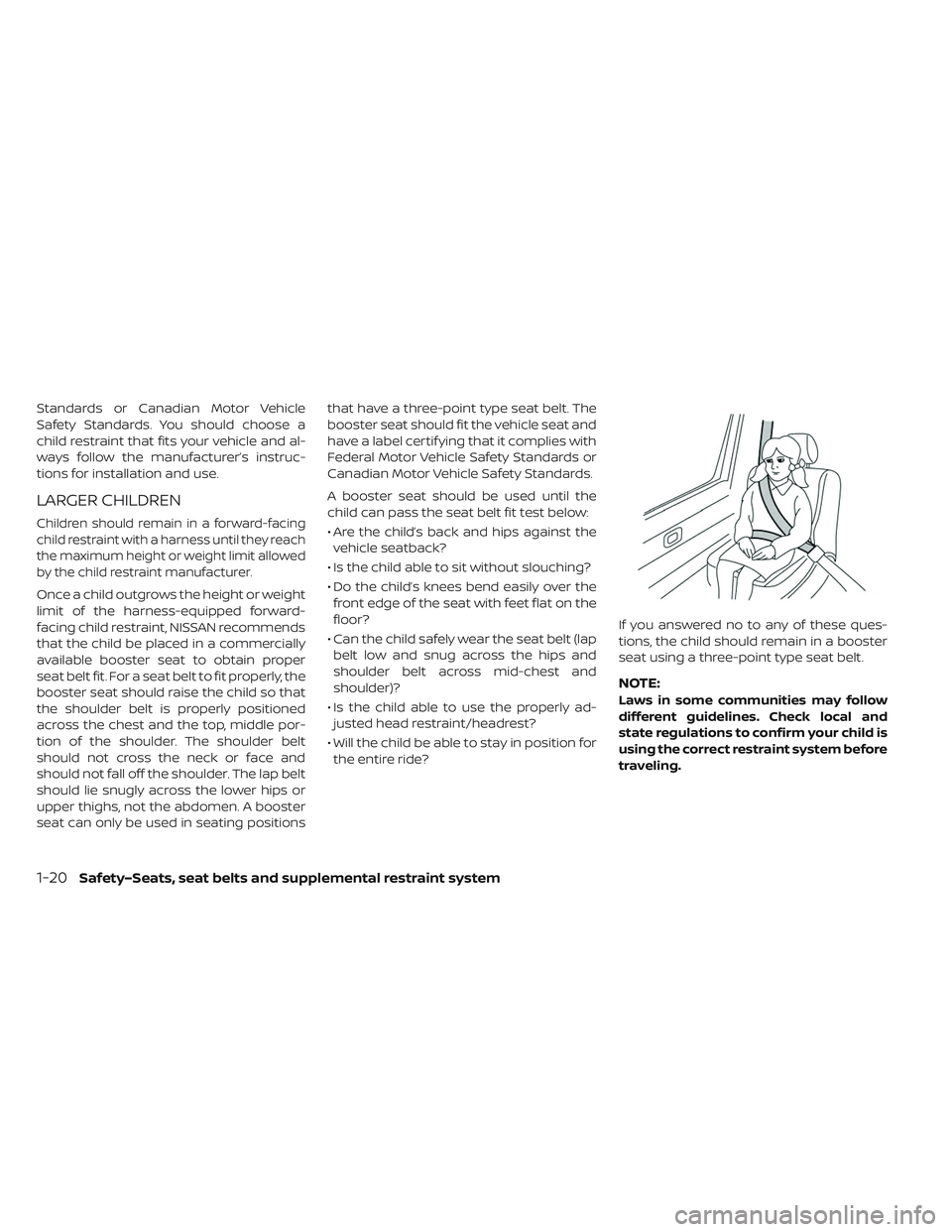
Standards or Canadian Motor Vehicle
Safety Standards. You should choose a
child restraint that fits your vehicle and al-
ways follow the manufacturer’s instruc-
tions for installation and use.
LARGER CHILDREN
Children should remain in a forward-facing
child restraint with a harness until they reach
the maximum height or weight limit allowed
by the child restraint manufacturer.
Once a child outgrows the height or weight
limit of the harness-equipped forward-
facing child restraint, NISSAN recommends
that the child be placed in a commercially
available booster seat to obtain proper
seat belt fit. For a seat belt to fit properly, the
booster seat should raise the child so that
the shoulder belt is properly positioned
across the chest and the top, middle por-
tion of the shoulder. The shoulder belt
should not cross the neck or face and
should not fall off the shoulder. The lap belt
should lie snugly across the lower hips or
upper thighs, not the abdomen. A booster
seat can only be used in seating positionsthat have a three-point type seat belt. The
booster seat should fit the vehicle seat and
have a label certif ying that it complies with
Federal Motor Vehicle Safety Standards or
Canadian Motor Vehicle Safety Standards.
A booster seat should be used until the
child can pass the seat belt fit test below:
• Are the child’s back and hips against the
vehicle seatback?
• Is the child able to sit without slouching?
• Do the child’s knees bend easily over the front edge of the seat with feet flat on the
floor?
• Can the child safely wear the seat belt (lap belt low and snug across the hips and
shoulder belt across mid-chest and
shoulder)?
• Is the child able to use the properly ad- justed head restraint/headrest?
• Will the child be able to stay in position for the entire ride? If you answered no to any of these ques-
tions, the child should remain in a booster
seat using a three-point type seat belt.
NOTE:
Laws in some communities may follow
different guidelines. Check local and
state regulations to confirm your child is
using the correct restraint system before
traveling.
1-20Safety–Seats, seat belts and supplemental restraint system
Page 132 of 610
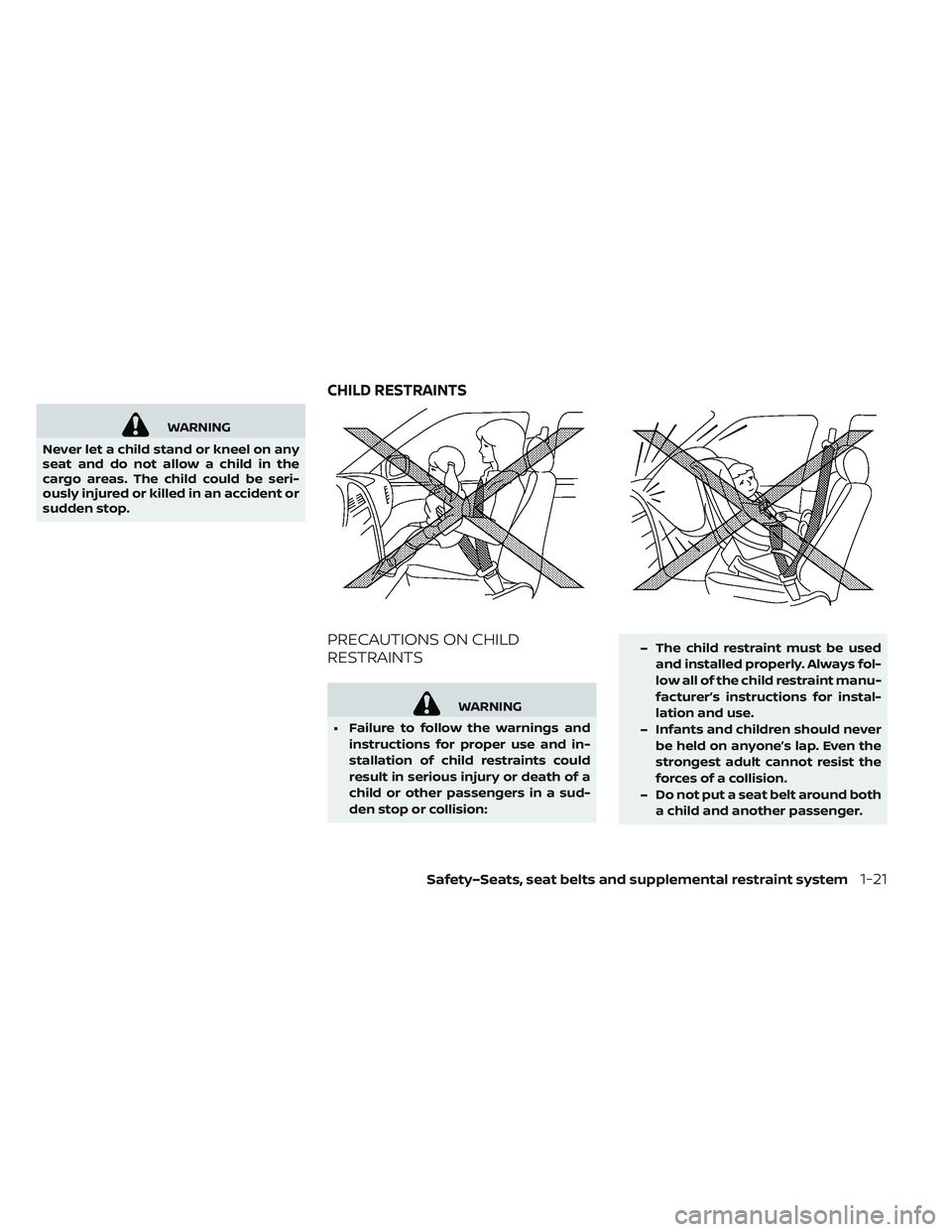
WARNING
Never let a child stand or kneel on any
seat and do not allow a child in the
cargo areas. The child could be seri-
ously injured or killed in an accident or
sudden stop.
PRECAUTIONS ON CHILD
RESTRAINTS
WARNING
• Failure to follow the warnings and
instructions for proper use and in-
stallation of child restraints could
result in serious injury or death of a
child or other passengers in a sud-
den stop or collision: –
The child restraint must be used
and installed properly. Always fol-
low all of the child restraint manu-
facturer’s instructions for instal-
lation and use.
– Infants and children should never
be held on anyone’s lap. Even the
strongest adult cannot resist the
forces of a collision.
– Do not put a seat belt around both
a child and another passenger.
CHILD RESTRAINTS
Safety–Seats, seat belts and supplemental restraint system1-21
Page 133 of 610
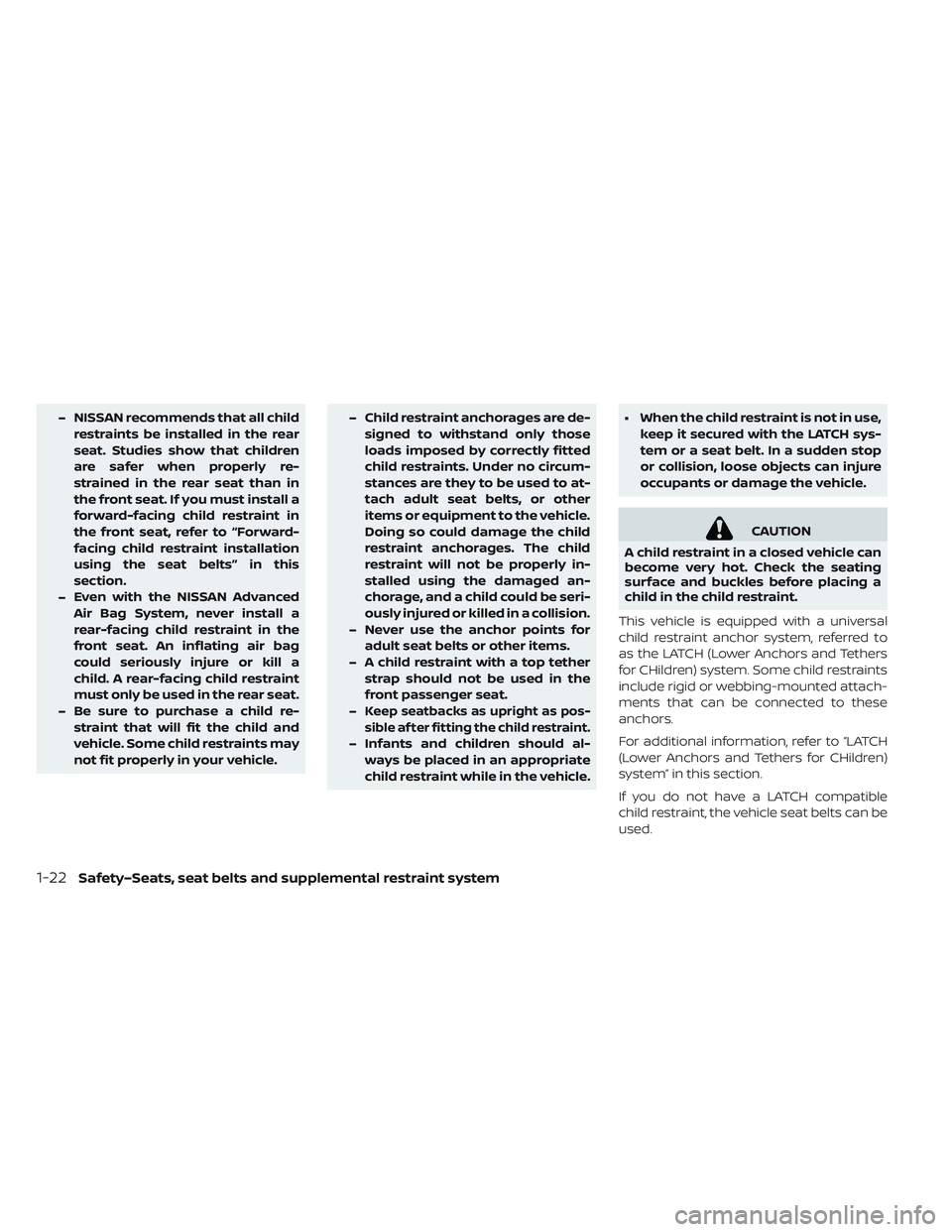
–NISSAN recommends that all child
restraints be installed in the rear
seat. Studies show that children
are safer when properly re-
strained in the rear seat than in
the front seat. If you must install a
forward-facing child restraint in
the front seat, refer to “Forward-
facing child restraint installation
using the seat belts” in this
section.
– Even with the NISSAN Advanced
Air Bag System, never install a
rear-facing child restraint in the
front seat. An inflating air bag
could seriously injure or kill a
child. A rear-facing child restraint
must only be used in the rear seat.
– Be sure to purchase a child re-
straint that will fit the child and
vehicle. Some child restraints may
not fit properly in your vehicle. –
Child restraint anchorages are de-
signed to withstand only those
loads imposed by correctly fitted
child restraints. Under no circum-
stances are they to be used to at-
tach adult seat belts, or other
items or equipment to the vehicle.
Doing so could damage the child
restraint anchorages. The child
restraint will not be properly in-
stalled using the damaged an-
chorage, and a child could be seri-
ously injured or killed in a collision.
– Never use the anchor points for
adult seat belts or other items.
– A child restraint with a top tether
strap should not be used in the
front passenger seat.
–
Keep seatbacks as upright as pos-
sible af ter fitting the child restraint.
– Infants and children should al-
ways be placed in an appropriate
child restraint while in the vehicle. •
When the child restraint is not in use,
keep it secured with the LATCH sys-
tem or a seat belt. In a sudden stop
or collision, loose objects can injure
occupants or damage the vehicle.
CAUTION
A child restraint in a closed vehicle can
become very hot. Check the seating
surface and buckles before placing a
child in the child restraint.
This vehicle is equipped with a universal
child restraint anchor system, referred to
as the LATCH (Lower Anchors and Tethers
for CHildren) system. Some child restraints
include rigid or webbing-mounted attach-
ments that can be connected to these
anchors.
For additional information, refer to “LATCH
(Lower Anchors and Tethers for CHildren)
system” in this section.
If you do not have a LATCH compatible
child restraint, the vehicle seat belts can be
used.
1-22Safety–Seats, seat belts and supplemental restraint system
Page 134 of 610
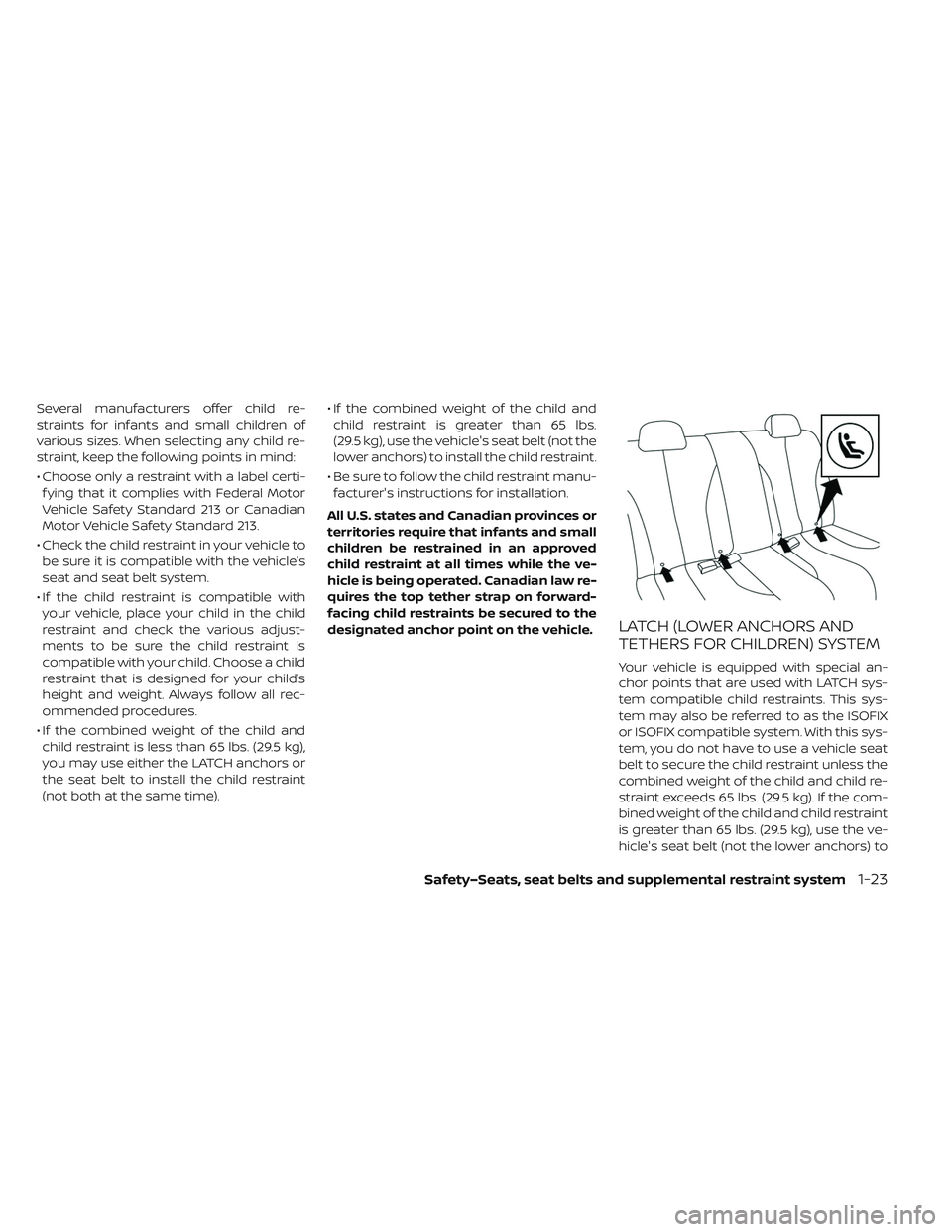
Several manufacturers offer child re-
straints for infants and small children of
various sizes. When selecting any child re-
straint, keep the following points in mind:
• Choose only a restraint with a label certi-f ying that it complies with Federal Motor
Vehicle Safety Standard 213 or Canadian
Motor Vehicle Safety Standard 213.
• Check the child restraint in your vehicle to be sure it is compatible with the vehicle’s
seat and seat belt system.
• If the child restraint is compatible with your vehicle, place your child in the child
restraint and check the various adjust-
ments to be sure the child restraint is
compatible with your child. Choose a child
restraint that is designed for your child’s
height and weight. Always follow all rec-
ommended procedures.
• If the combined weight of the child and child restraint is less than 65 lbs. (29.5 kg),
you may use either the LATCH anchors or
the seat belt to install the child restraint
(not both at the same time). • If the combined weight of the child and
child restraint is greater than 65 lbs.
(29.5 kg), use the vehicle's seat belt (not the
lower anchors) to install the child restraint.
• Be sure to follow the child restraint manu- facturer's instructions for installation.
All U.S. states and Canadian provinces or
territories require that infants and small
children be restrained in an approved
child restraint at all times while the ve-
hicle is being operated. Canadian law re-
quires the top tether strap on forward-
facing child restraints be secured to the
designated anchor point on the vehicle.
LATCH (LOWER ANCHORS AND
TETHERS FOR CHILDREN) SYSTEM
Your vehicle is equipped with special an-
chor points that are used with LATCH sys-
tem compatible child restraints. This sys-
tem may also be referred to as the ISOFIX
or ISOFIX compatible system. With this sys-
tem, you do not have to use a vehicle seat
belt to secure the child restraint unless the
combined weight of the child and child re-
straint exceeds 65 lbs. (29.5 kg). If the com-
bined weight of the child and child restraint
is greater than 65 lbs. (29.5 kg), use the ve-
hicle's seat belt (not the lower anchors) to
Safety–Seats, seat belts and supplemental restraint system1-23
Page 135 of 610
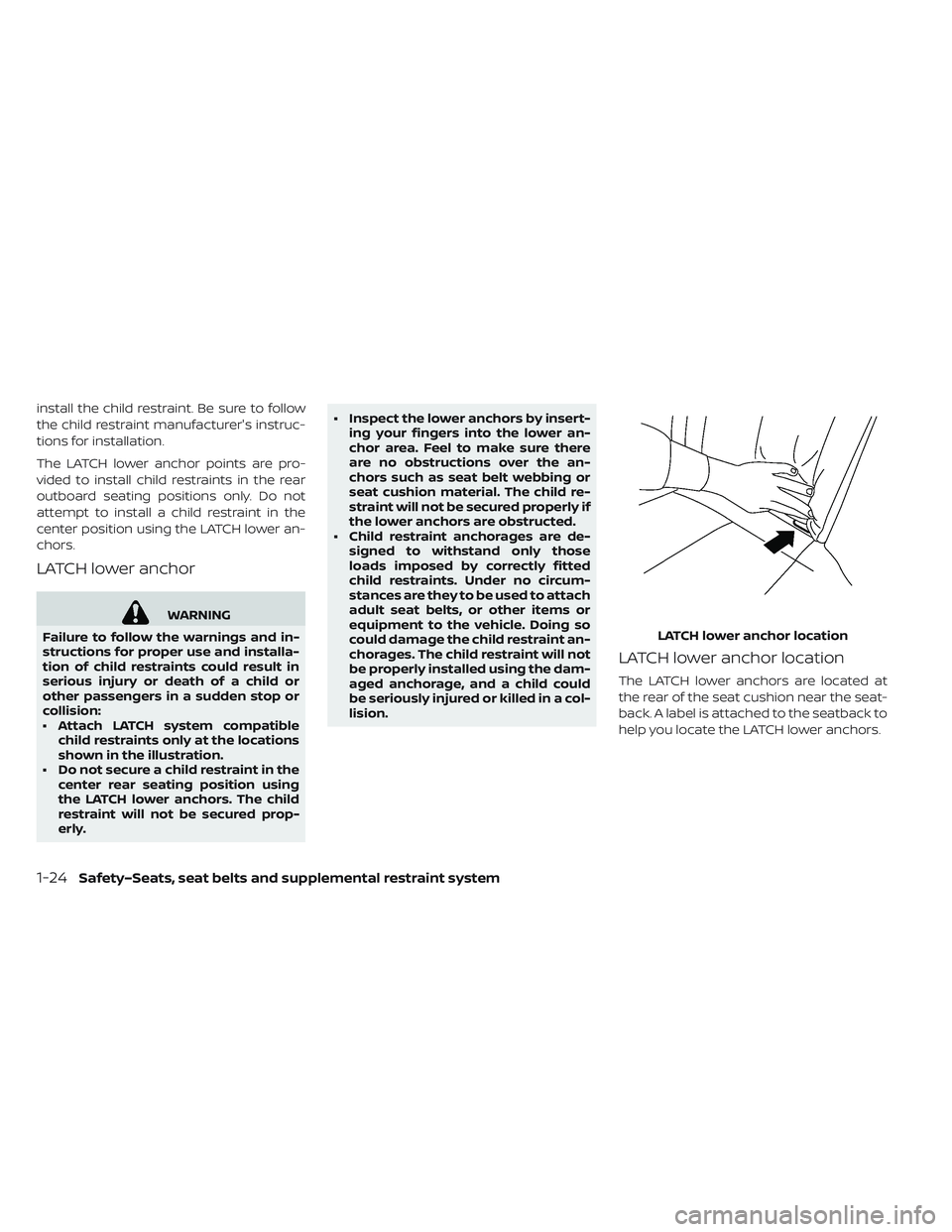
install the child restraint. Be sure to follow
the child restraint manufacturer's instruc-
tions for installation.
The LATCH lower anchor points are pro-
vided to install child restraints in the rear
outboard seating positions only. Do not
attempt to install a child restraint in the
center position using the LATCH lower an-
chors.
LATCH lower anchor
WARNING
Failure to follow the warnings and in-
structions for proper use and installa-
tion of child restraints could result in
serious injury or death of a child or
other passengers in a sudden stop or
collision:
• Attach LATCH system compatible child restraints only at the locations
shown in the illustration.
• Do not secure a child restraint in the center rear seating position using
the LATCH lower anchors. The child
restraint will not be secured prop-
erly. • Inspect the lower anchors by insert-
ing your fingers into the lower an-
chor area. Feel to make sure there
are no obstructions over the an-
chors such as seat belt webbing or
seat cushion material. The child re-
straint will not be secured properly if
the lower anchors are obstructed.
• Child restraint anchorages are de- signed to withstand only those
loads imposed by correctly fitted
child restraints. Under no circum-
stances are they to be used to attach
adult seat belts, or other items or
equipment to the vehicle. Doing so
could damage the child restraint an-
chorages. The child restraint will not
be properly installed using the dam-
aged anchorage, and a child could
be seriously injured or killed in a col-
lision.
LATCH lower anchor location
The LATCH lower anchors are located at
the rear of the seat cushion near the seat-
back. A label is attached to the seatback to
help you locate the LATCH lower anchors. LATCH lower anchor location
1-24Safety–Seats, seat belts and supplemental restraint system
Page 136 of 610
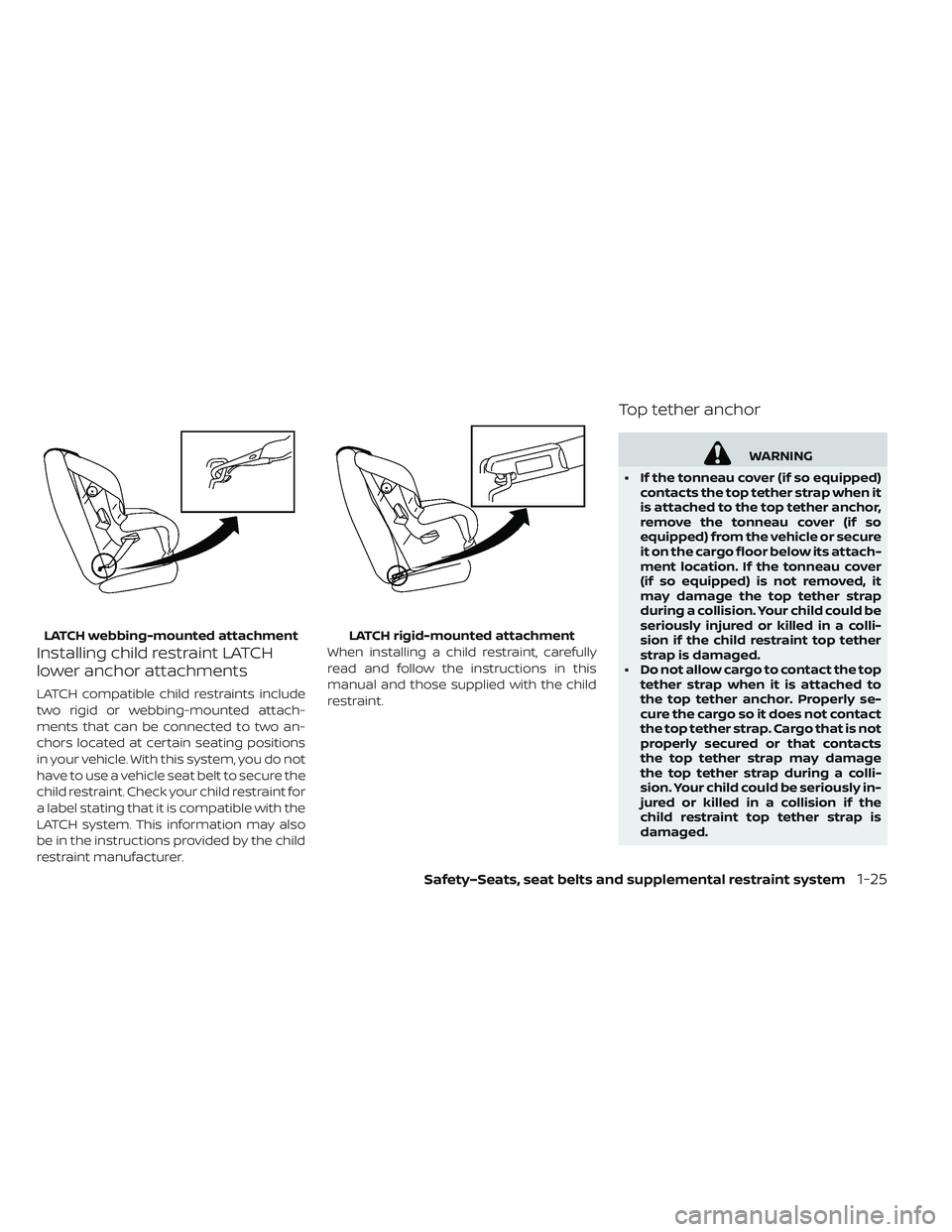
Installing child restraint LATCH
lower anchor attachments
LATCH compatible child restraints include
two rigid or webbing-mounted attach-
ments that can be connected to two an-
chors located at certain seating positions
in your vehicle. With this system, you do not
have to use a vehicle seat belt to secure the
child restraint. Check your child restraint for
a label stating that it is compatible with the
LATCH system. This information may also
be in the instructions provided by the child
restraint manufacturer.When installing a child restraint, carefully
read and follow the instructions in this
manual and those supplied with the child
restraint.
Top tether anchor
WARNING
• If the tonneau cover (if so equipped) contacts the top tether strap when it
is attached to the top tether anchor,
remove the tonneau cover (if so
equipped) from the vehicle or secure
it on the cargo floor below its attach-
ment location. If the tonneau cover
(if so equipped) is not removed, it
may damage the top tether strap
during a collision. Your child could be
seriously injured or killed in a colli-
sion if the child restraint top tether
strap is damaged.
• Do not allow cargo to contact the top tether strap when it is attached to
the top tether anchor. Properly se-
cure the cargo so it does not contact
the top tether strap. Cargo that is not
properly secured or that contacts
the top tether strap may damage
the top tether strap during a colli-
sion. Your child could be seriously in-
jured or killed in a collision if the
child restraint top tether strap is
damaged.
LATCH webbing-mounted attachment LATCH rigid-mounted attachment
Safety–Seats, seat belts and supplemental restraint system1-25
Page 137 of 610
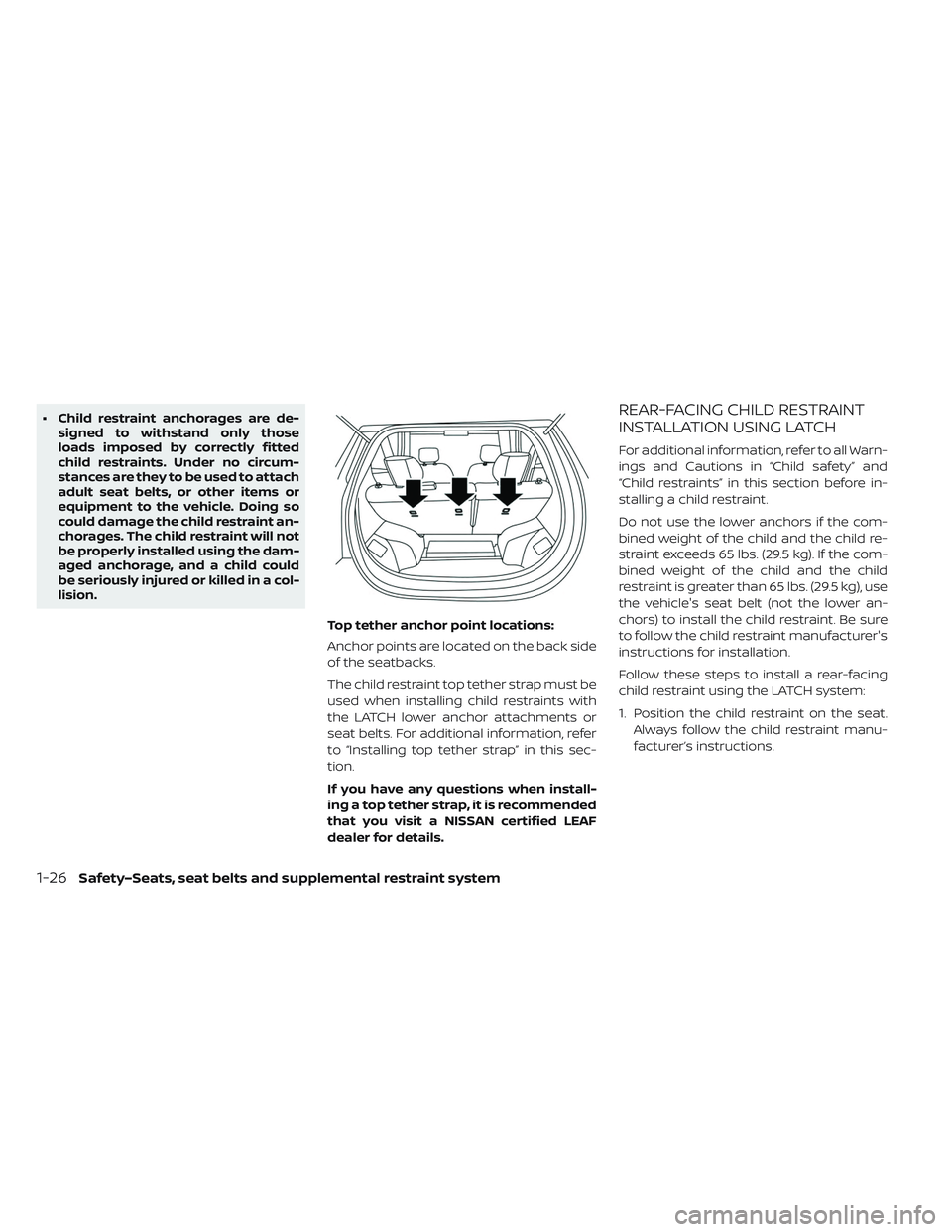
• Child restraint anchorages are de-signed to withstand only those
loads imposed by correctly fitted
child restraints. Under no circum-
stances are they to be used to attach
adult seat belts, or other items or
equipment to the vehicle. Doing so
could damage the child restraint an-
chorages. The child restraint will not
be properly installed using the dam-
aged anchorage, and a child could
be seriously injured or killed in a col-
lision.
Top tether anchor point locations:
Anchor points are located on the back side
of the seatbacks.
The child restraint top tether strap must be
used when installing child restraints with
the LATCH lower anchor attachments or
seat belts. For additional information, refer
to “Installing top tether strap” in this sec-
tion.
If you have any questions when install-
ing a top tether strap, it is recommended
that you visit a NISSAN certified LEAF
dealer for details.REAR-FACING CHILD RESTRAINT
INSTALLATION USING LATCH
For additional information, refer to all Warn-
ings and Cautions in “Child safety” and
“Child restraints” in this section before in-
stalling a child restraint.
Do not use the lower anchors if the com-
bined weight of the child and the child re-
straint exceeds 65 lbs. (29.5 kg). If the com-
bined weight of the child and the child
restraint is greater than 65 lbs. (29.5 kg), use
the vehicle's seat belt (not the lower an-
chors) to install the child restraint. Be sure
to follow the child restraint manufacturer's
instructions for installation.
Follow these steps to install a rear-facing
child restraint using the LATCH system:
1. Position the child restraint on the seat.Always follow the child restraint manu-
facturer’s instructions.
1-26Safety–Seats, seat belts and supplemental restraint system
Page 138 of 610
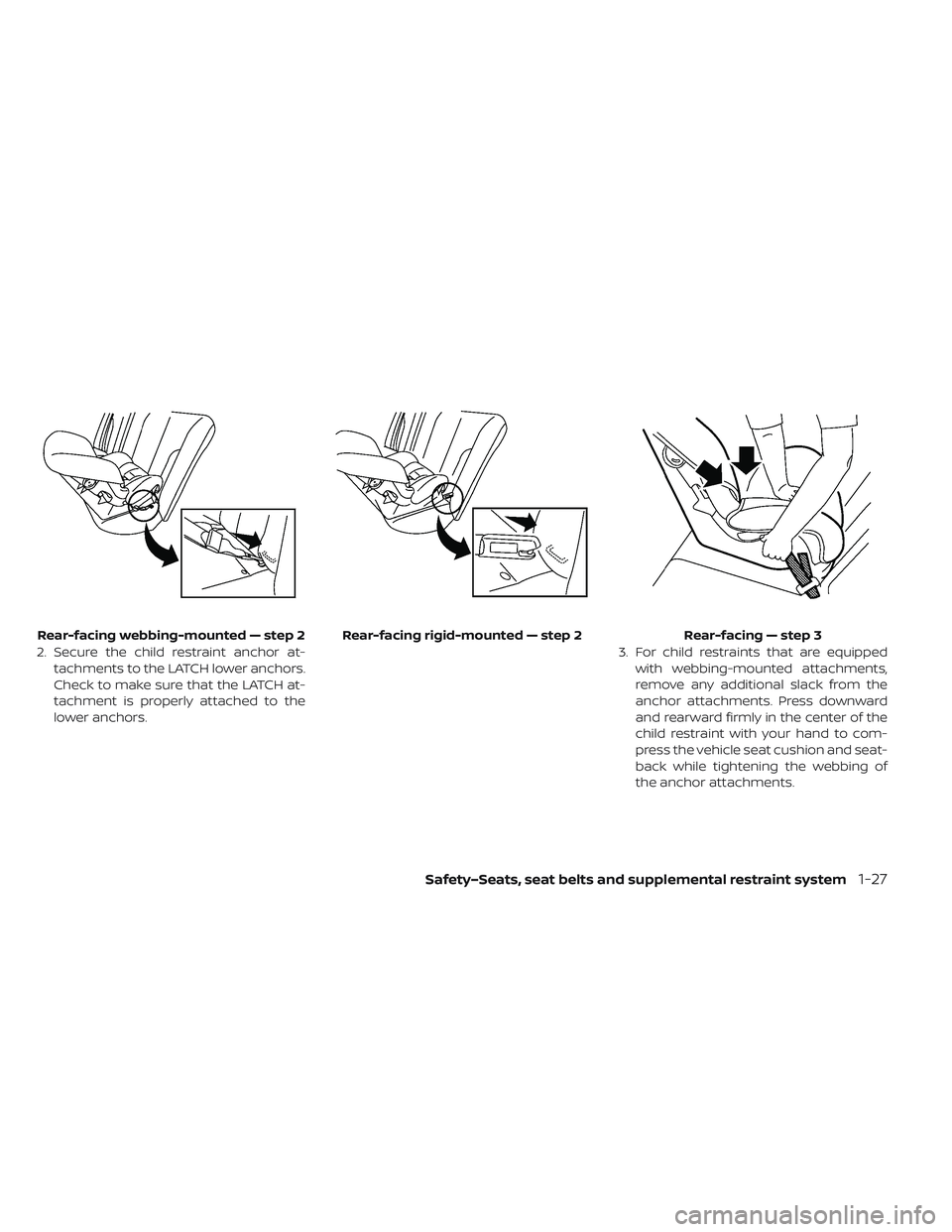
2. Secure the child restraint anchor at-tachments to the LATCH lower anchors.
Check to make sure that the LATCH at-
tachment is properly attached to the
lower anchors. 3. For child restraints that are equipped
with webbing-mounted attachments,
remove any additional slack from the
anchor attachments. Press downward
and rearward firmly in the center of the
child restraint with your hand to com-
press the vehicle seat cushion and seat-
back while tightening the webbing of
the anchor attachments.
Rear-facing webbing-mounted — step 2 Rear-facing rigid-mounted — step 2
Rear-facing — step 3
Safety–Seats, seat belts and supplemental restraint system1-27
Page 139 of 610
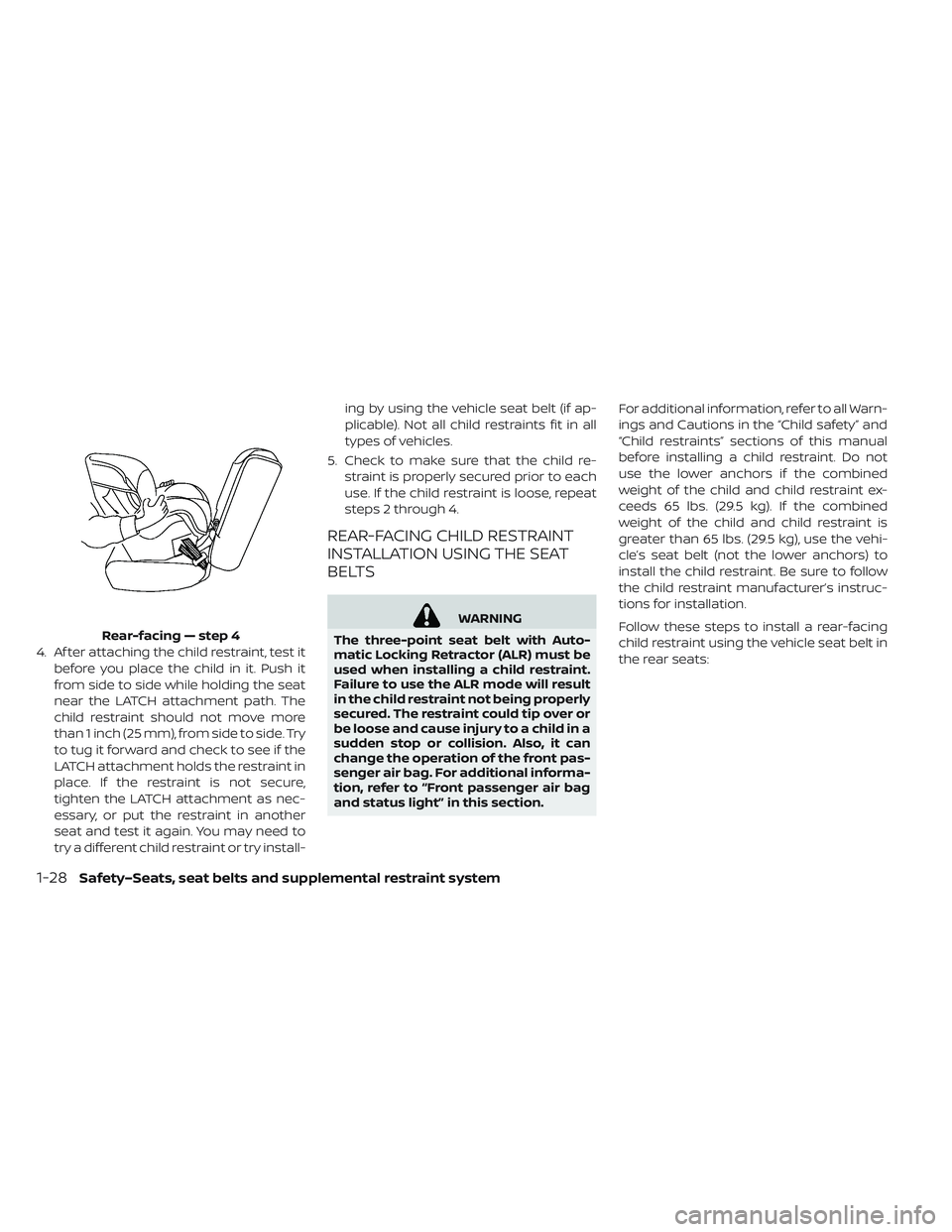
4. Af ter attaching the child restraint, test itbefore you place the child in it. Push it
from side to side while holding the seat
near the LATCH attachment path. The
child restraint should not move more
than 1 inch (25 mm), from side to side. Try
to tug it forward and check to see if the
LATCH attachment holds the restraint in
place. If the restraint is not secure,
tighten the LATCH attachment as nec-
essary, or put the restraint in another
seat and test it again. You may need to
try a different child restraint or try install- ing by using the vehicle seat belt (if ap-
plicable). Not all child restraints fit in all
types of vehicles.
5. Check to make sure that the child re- straint is properly secured prior to each
use. If the child restraint is loose, repeat
steps 2 through 4.
REAR-FACING CHILD RESTRAINT
INSTALLATION USING THE SEAT
BELTS
WARNING
The three-point seat belt with Auto-
matic Locking Retractor (ALR) must be
used when installing a child restraint.
Failure to use the ALR mode will result
in the child restraint not being properly
secured. The restraint could tip over or
be loose and cause injury to a child in a
sudden stop or collision. Also, it can
change the operation of the front pas-
senger air bag. For additional informa-
tion, refer to “Front passenger air bag
and status light” in this section. For additional information, refer to all Warn-
ings and Cautions in the “Child safety” and
“Child restraints” sections of this manual
before installing a child restraint. Do not
use the lower anchors if the combined
weight of the child and child restraint ex-
ceeds 65 lbs. (29.5 kg). If the combined
weight of the child and child restraint is
greater than 65 lbs. (29.5 kg), use the vehi-
cle’s seat belt (not the lower anchors) to
install the child restraint. Be sure to follow
the child restraint manufacturer’s instruc-
tions for installation.
Follow these steps to install a rear-facing
child restraint using the vehicle seat belt in
the rear seats:
Rear-facing — step 4
1-28Safety–Seats, seat belts and supplemental restraint system
Page 140 of 610
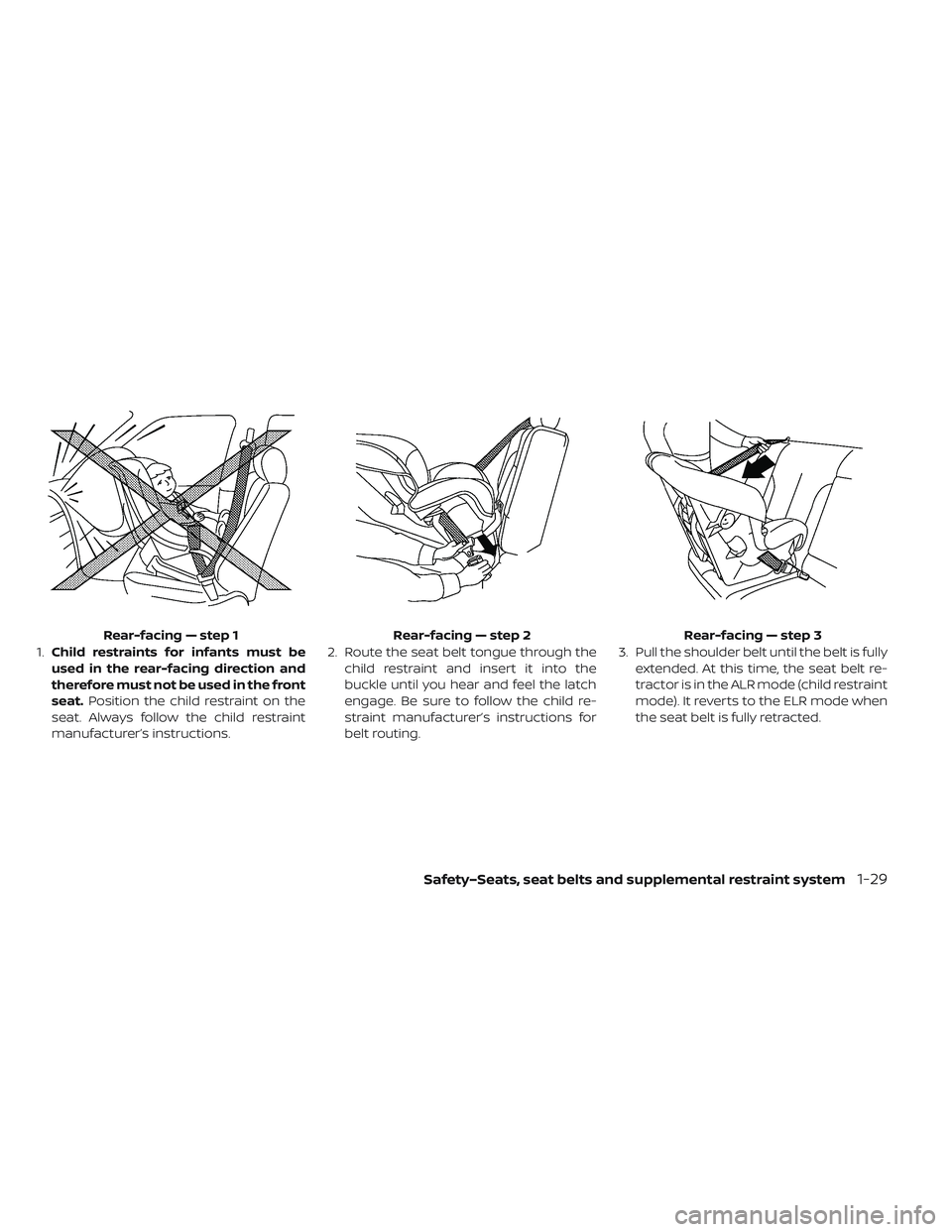
1.Child restraints for infants must be
used in the rear-facing direction and
therefore must not be used in the front
seat. Position the child restraint on the
seat. Always follow the child restraint
manufacturer’s instructions. 2. Route the seat belt tongue through the
child restraint and insert it into the
buckle until you hear and feel the latch
engage. Be sure to follow the child re-
straint manufacturer’s instructions for
belt routing. 3. Pull the shoulder belt until the belt is fully
extended. At this time, the seat belt re-
tractor is in the ALR mode (child restraint
mode). It reverts to the ELR mode when
the seat belt is fully retracted.
Rear-facing — step 1
Rear-facing — step 2 Rear-facing — step 3
Safety–Seats, seat belts and supplemental restraint system1-29